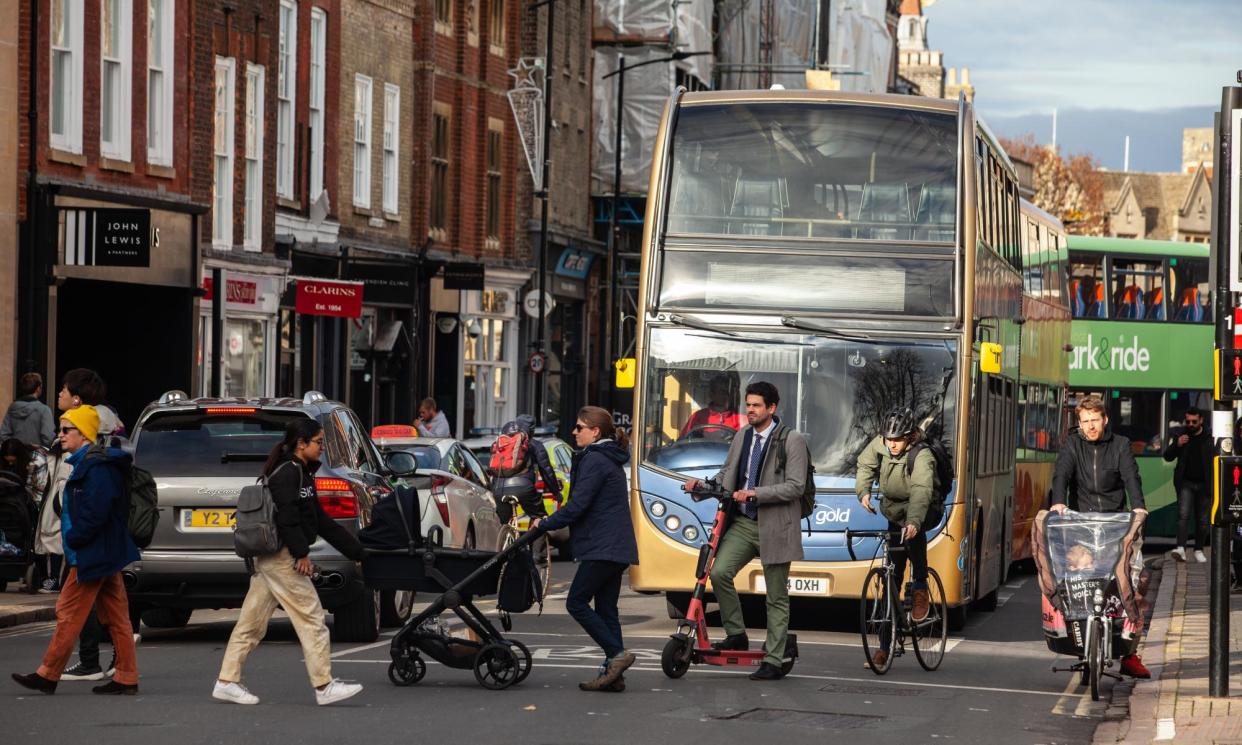Ministers prioritised driving in England partly due to conspiracy theories

Ministers decided to prioritise driving over active travel because of worries among ministers about “15-minute cities”, documents seen by the Guardian show.
They indicate that a significant shift in transport policy was guided at least in part by conspiracy theories.
Ministers began considering curbs on cycling and walking schemes in March last year, one document said, “in response to concerns about 15-minute cities”, an urban planning concept that Rishi Sunak’s government has repeatedly mischaracterised.
Other policy papers, uncovered as part of a legal challenge by the Transport Action Network (TAN), show officials warned ministers that a parallel crackdown on low traffic neighbourhoods (LTNs) was likely to be legally “challenging”.
Another document advised ministers they should drop plans to improve active travel “quietly”, adding: “We would not propose to make any public announcement to this effect.”
Devised by the French-based urbanist, Carlos Moreno, 15-minute cities are a broad planning concept based on people living within easy reach of workplaces and schools, as well as local amenities, gradually reducing the need for short car trips.
The idea caught the attention of a range of conspiracy theorists, who see it as a supposed part of a “great reset” or “climate lockdown” in which people are forcibly kept within their local neighbourhood and not allowed to travel.
In his speech to the Conservative conference in October, Mark Harper, the transport secretary, described 15-minutes cities as schemes in which “local councils can decide how often you go to the shops”, which was incorrect and is something that has never been proposed in the UK.
While many critics assumed at the time this was just rhetoric, the documents indicate Harper and the Department for Transport (DfT) used this definition as the basis for one of the biggest shifts in transport policy for decades.
In September, Sunak ended years of policies aimed to promote walking and cycling with his plan for drivers, which promised to crack down on “anti-car measures” like 20mph speed limits and LTNs, which seek to limit through-traffic on residential streets.
The document from March proposes removing pro-active travel measures introduced during Covid because of worries about 15-minute cities.
It is understood that officials were referring to plans to extend LTN-type schemes to wider areas, such as one due to begin in Oxford next year. This has been widely confused with separate 15-minute city ideas.
Moreno has previously written to Sunak to warn that misinformation has led to him and his family receiving death threats. He told the Guardian that the UK government’s notion of 15-minute cities “appears to be used to stir up fear and opposition, particularly leveraging the idea that the use of individual cars is a fundamental freedom right”.
TAN, which is being assisted by Dale Vince, the green energy magnate and campaigner, has sought a judicial review of the decision to scrap government guidance to councils introduced during Covid to help more people walk and cycle.
The group’s director, Chris Todd, said: “These shocking revelations show Rishi Sunak was more concerned with crazy conspiracy theories than helping people travel safely and cheaply. It’s absurd for ministers to be swept away by hysteria about 15-minute cities, at the same time that other government departments were defending them.”
The DfT documents also show that officials repeatedly warned ministers that other aspects of the plan for motorists, notably the idea of potentially forcing councils to remove LTNs, were unlikely to succeed.
While a number were introduced during Covid, the wider idea of LTNs – using bollards or other barriers to block through motor traffic on smaller urban roads without impeding cyclists or pedestrians – has been used for decades.
A DfT briefing paper for Downing Street in August warned that a full review of existing LTNs “could entail a very large piece of analytical work”, adding that “there is an expectation among media” that the plan for motorists would nonetheless target them.
The DfT said it could not comment on ongoing legal action. A spokesperson said: “It is important that people who choose to walk and cycle can do so safely, but this should not come at the cost of people who rely on cars or prevent the emergency services from accessing roads.
“Our plan for drivers backs the majority of the public who drive and will review guidance on over-zealous traffic schemes that impinge on people’s freedoms, such as low traffic neighbourhoods, to ensure there is strong local support.”
What is a 15-minute city?
The idea of a 15-minute city is relatively new – first outlined in 2016 by Carlos Moreno of Pantheon-Sorbonne university in Paris – and none has arguably been created yet. But it is a concept that has gained significant prominence – much of it under false pretences.
At its heart, this is an urbanism concept, a framework rather than a specific plan: trying to gradually change cities so people tend to live relatively close to shops, workplaces and other amenities. With this comes an inevitable shift from car trips to walking, cycling and public transport.
However, the adoption of the idea, even as a long-term aspiration, by cities as varied as Paris, Bogotá and Oxford has prompted a wave of conspiracies about a supposed transnational plot to block people from travelling beyond their local neighbourhood.
There is zero evidence for this, and even when traffic schemes do exist, such as Oxford’s ambitious plan to install filters on six roads to discourage short car trips on residential streets, they are not 15-minute cities, or even described as such.


